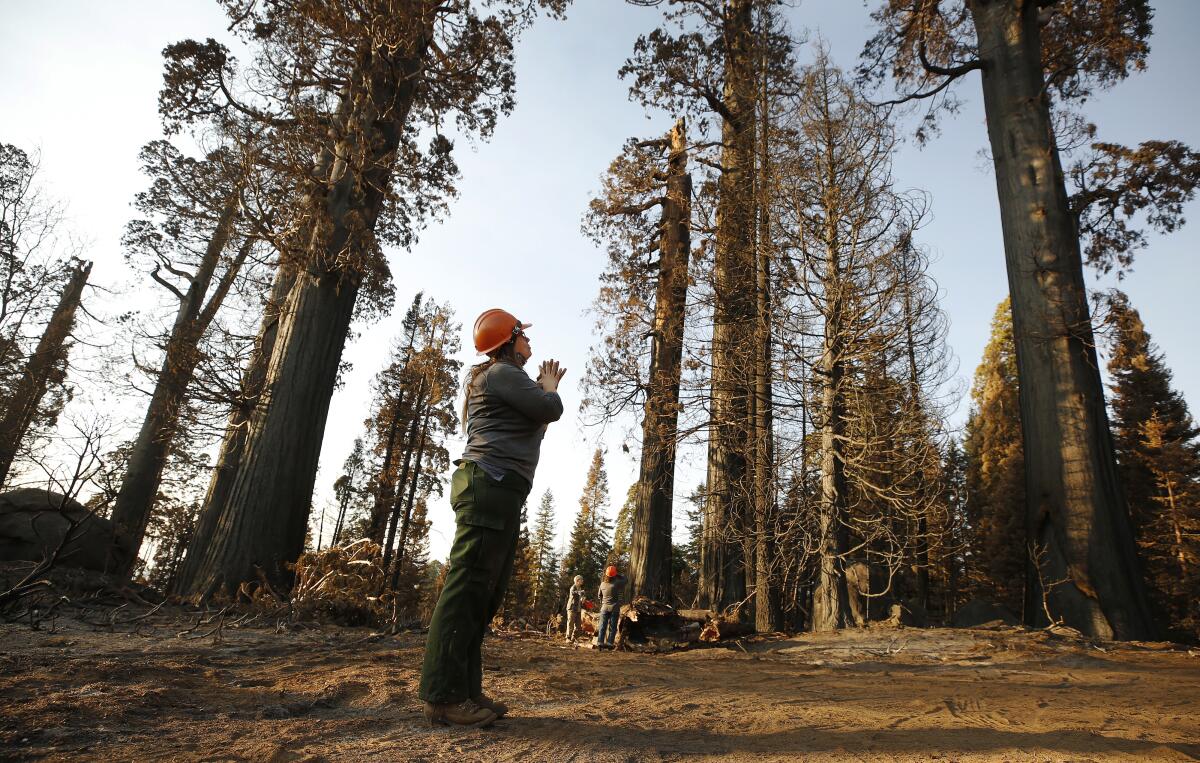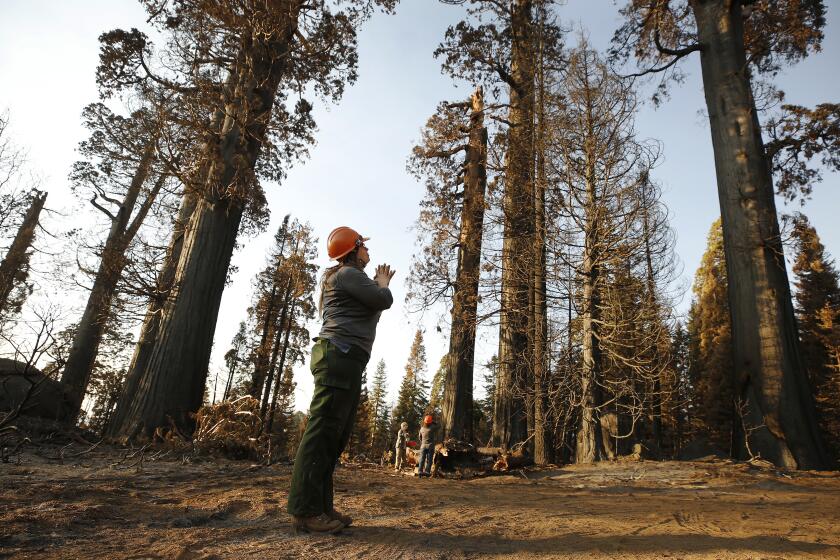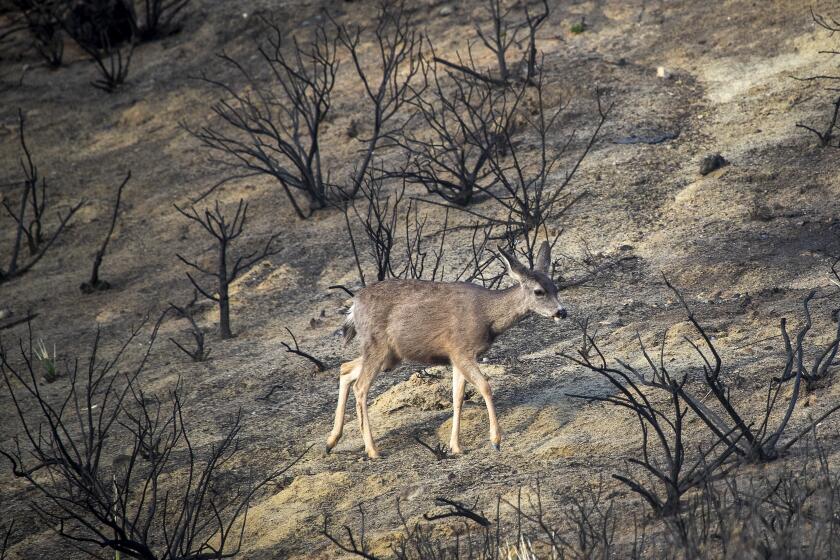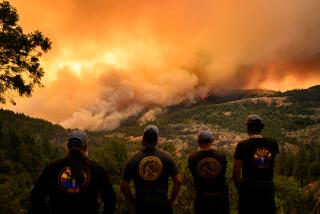As wildfires decimate the giant sequoia, California faces unprecedented loss

- Share via
When wildfire tore through giant sequoia groves in the Sierra Nevada last year, researchers estimated hundreds of the towering trees — maybe 1,000 — were killed.
Now, almost nine months later, experts have revised that figure tenfold. A new draft report puts the toll at 7,500 to 10,600 trees — 10% to 14% of the world’s natural population.
“The whole thing is surprising and devastating and depressing,” said Christy Brigham, chief of resources management and science at Sequoia and Kings Canyon National Parks and lead author of the report.
The finding startled scientists because sequoias are adapted to thrive in fire, with bark that’s up to 2 feet thick, branches that reach above flames and cones that release seeds when exposed to a burst of heat.
Still, as the effects of human-caused climate change and aggressive fire suppression have combined to drive bigger, more intense wildfires, these ancient giants are increasingly no match for the conditions ecologists are seeing on the ground.
“They’re one of the most fire-adapted species on Earth, and that is one way that this really is a warning sign much bigger than the trees themselves,” Brigham said.
“If we’re looking at forest fires that can now kill these old trees that have survived dozens, if not 100 or more previous wildfires, that’s a very bad sign.”
This year’s Castle fire killed hundreds of giant sequoias, the latest in a string of Sierra Nevada wildfires that is taking an alarming toll on the world’s most massive trees.
The Castle fire was one of hundreds sparked last August by a siege of dry lightning strikes that was bookended by a pair of historic heat waves.
The fire burned through portions of about 20 giant sequoia groves on the western slopes of the Sierra, the only place on the planet they naturally grow.
Brigham, with help from researchers at the U.S. Geological Survey, U.S. Forest Service and conservation group Save the Redwoods League, came up with the revised estimate of dead trees based on satellite imagery.
The report is expected to be published this summer after it undergoes peer review. Now that the snow has thawed, teams of researchers are starting to go into the field to verify its findings.
The mortality estimates focus on trees that had trunks of at least 4 feet in diameter, meaning they were at least 100 to 200 years old. Some that burned were much older, Brigham said.
“It’s untold losses,” she said. “When I have walked in two of the high-severity burned groves, the groves that really burned hot, we see really large dead trees, trees that probably are 1,500 to 3,000 years old.”

A giant sequoia can survive a wildfire if just 5% of its crown remains unscorched. But the intensity of the Castle fire caused some of the trees’ crowns to combust on a scale researchers had never seen before.
“The first time we ever saw that was in 2015 in the Rough fire, and it only happened to a very small number of trees,” Brigham said. “So this is a new, unprecedented fire effect.”
And severe, sequoia-destroying fires have been on the rise over the last decade, said Nate Stephenson, a research ecologist with the U.S. Geological Survey who also contributed to the report. He recalled when the Pierce fire burned through the Redwood Mountain grove in 1987, killing 14 sequoias.
Climate, weather, human behavior and even luck will dictate whether the 2021 wildfire season goes down in the record books like 2020.
“To the best of our knowledge, that was the most that had been killed in historic times in a wildfire,” he said. “Then things started to shift.”
Fast-forward to the Rough fire in 2015, which killed at least 100 sequoias; in 2017, the Pier and Railroad fires killed about 120, Stephenson said.
“Then you get to the Castle fire where it’s multiple thousands and clearly out of bounds of anything we knew about in the historical record,” he said.
Researchers believe this is because sequoias evolved to live with low- and mixed-intensity ground blazes, “fire that doesn’t get up into the canopy and certainly doesn’t burn up the canopy of 100-foot-tall, 2,000-year-old trees,” Brigham said.
These types of fires used to be more common due to Indigenous burning practices, as well as lightning strikes that weren’t immediately extinguished.
“In a given grove, you probably had a fire burning somewhere in it every 10 years or so,” Stephenson said. “For a given sequoia, you might have a fire at its base every 20 years or so. That kept the forests a lot more open and the fires, when they did burn, to lower-intensity fires because there wasn’t a lot of time for dead material to build up on the ground.”
But a century of aggressive suppression tactics meant some of the groves that burned last year had no recent history of fire, leading to an accumulation of dead trees and litter.
That was compounded by a drought that killed scores of pines and firs from 2012 to 2016, both directly and as a result of fatal bark beetle infestations. And last summer’s hot, dry weather ensured those so-called ladder fuels capable of carrying the fire up into the canopy were bone-dry and combustible.
The combination made the Castle fire burn extraordinarily hot and high, rendering the sequoias’ defenses inadequate, said Paul Ringgold, chief program officer for Save the Redwoods League, which also provided data for the report.
“Sequoias are just not able to withstand that kind of fire in that kind of environment,” he said.
The trees are also facing another new enemy. For the first time, researchers have found that bark beetles are also killing sequoias. They’ve documented 33 sequoias within Sequoia and Kings Canyon National Parks that have been killed by a genus of cedar bark beetle that they’re investigating to determine if it’s its own species, Stephenson said.
“The reason it worried us is we thought, ‘This is new to us,’” he said. “And if it continues to get warmer, this is going to become a bigger and bigger problem.”
Each of the sequoias killed by beetles was suffering from the effects of drought and had its base scarred by a recent fire, weakening the tree by reducing the amount of water that could make it to the top. Scientists are working to determine what role each factor played.
“The forest is changing, and the drought and climate change are really stressing these forests in new ways with both fire and beetles,” Brigham said.
The loss of the sequoias could accelerate the pace of that change. The trees remove a massive amount of carbon dioxide from the atmosphere and store it for thousands of years, and they serve as a habitat for wildlife like the Pacific fisher and spotted owl.
They also defend against erosion and play a crucial role in the state’s natural water storage system, helping retain the snowpack longer by shielding it from the sunlight so it melts more slowly and supplies a steady stream of water to the reservoirs and the San Joaquin Valley when it’s needed.
“We have this great water tower in the Sierra Nevada and it may not be as good at supplying water the way we want water supplied to us,” Stephenson said. “Or maybe the same amount will come but it will come out faster, maybe carrying a lot of sediment with it.”
Researchers are also worried that the severity of the recent fire could mean some areas simply can’t regenerate on their own.
In April, a group including Brigham and Stephenson hiked into a high-intensity burn area in Sequoia National Park. On the way, they traveled through less severely burned areas and saw “lots of little sequoia seedlings on the ground,” Stephenson said: As expected, the fire had caused seeds to fall in the autumn and germinate in the spring.
“When we got into the core area where the really severe crown fire was, we could not find a single giant sequoia seedling,” Stephenson said. “And that was shocking to me.”
They believe the fire burned through the little pedestals that hold the cones on the trees, causing them to drop on the ground, where they were destroyed.
Groups including Save the Redwoods League are already replanting seedlings in those areas, Ringgold said.
“That said, it will take thousands of years for those forests to return to the majesty that we’ve seen them in in our lifetime,” he said.
Those areas might also turn into shrub fields, and it could be harder for trees to grow there in the future, Stephenson said.
“It’s conceivable that if it continues to warm and warm and warm, you might not get anything looking like the forest used to be there coming back in,” he said.
At the same time, forest managers are confident it’s possible to make the forest more resilient to future fires through treatments like prescribed burning and thinning. It’s also important for people to work together to reduce greenhouse gases, they said.
“This is not a hopeless situation,” Brigham said. “This is a call to action.”
More to Read
Sign up for Essential California
The most important California stories and recommendations in your inbox every morning.
You may occasionally receive promotional content from the Los Angeles Times.
















